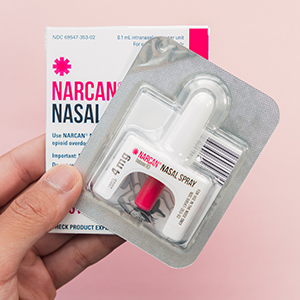Naloxone (Narcan®): A Lifesaving Medication
What Is Naloxone?
Naloxone (aka Narcan®) is an over-the-counter medicine that rapidly reverses an opioid overdose. In the event of an overdose, a person’s breathing can be dangerously slowed or stopped, causing brain damage or death. Naloxone/Narcan® can quickly restore normal breathing during an overdose.

Narcan®/naloxone is available in all Munson Healthcare emergency departments and pharmacies without a prescription. In addition, FREE naloxone/Narcan® is available in many communities across Northern Michigan, including at 25 Munson Healthcare outdoor locations. Scroll below to learn more.
Signs of an overdose may include:
- Small, constricted “pinpoint pupils”
- Falling asleep or loss of consciousness
- Limp body
- Slow, shallow breathing
- Choking or gurgling sounds
- Cold and/or clammy skin
- Discolored skin (especially in lips and nails)
Nalaxone is available as a nasal spray or can be injected into the muscle, under the skin, or in a vein. It can be safely given to people of all ages, from infants to older adults. Naloxone will not harm someone if you give it to them and they are not overdosing. If you suspect an overdose, administer naloxone.
Who Should Carry Naloxone/Narcan®?

Anyone at risk for an opioid overdose should carry naloxone/Narcan®, especially people struggling with an Opioid Use Disorder. This includes:
- People who are taking a prescribed opioid medication
- People who use opioids and benzodiazepines together
- People who use illicit opioids like heroin
Because you can’t use naloxone/Narcan® on yourself, let others know you have it in case you experience an opioid overdose.
Carrying naloxone/Narcan® is no different than carrying an EpiPen for allergies. It is an extra layer of protection in the event of an emergency. In nearly 40% of overdose deaths, someone else was present. Having naloxone/Narcan® available allows bystanders to help a potentially fatal overdose.
Where to Find Naloxone/Narcan®
Naloxone/Narcan® is available at a location near you in Northern Michigan. In partnership with Harm Reduction Michigan, Munson Healthcare offers free, anonymous, 24/7 access via outside distribution boxes (pictured above) at 25 locations throughout the region. In addition, Naloxone/Narcan® is also available at all Munson Healthcare emergency departments and pharmacies (no prescription needed) as well as other locations throughout our region.
What to Do If You Suspect an Overdose
- Call 911 immediately.
- Administer naloxone.
- Try to keep the person awake or breathing.
- Move the person to their left side to prevent choking.
- Stay with them until emergency assistance arrives.
Additional Naloxone Resources
- NextDistro (online and mail-based program)
- Harm Reduction Michigan